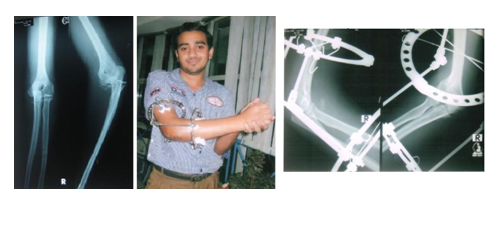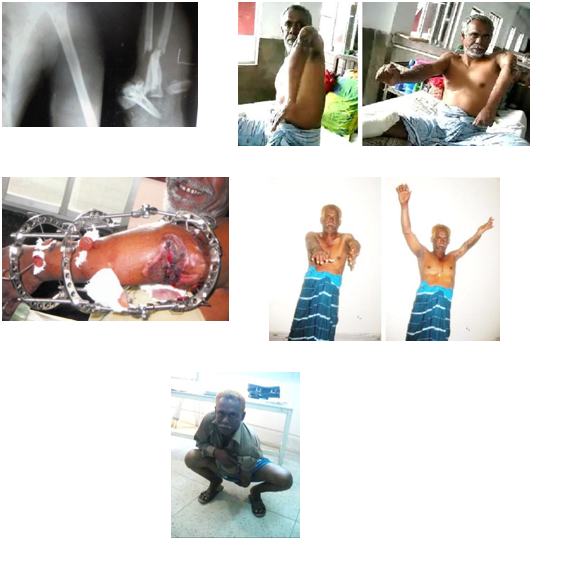MOJ
eISSN: 2374-6939


Research Article Volume 3 Issue 5
1Chief Consultant, Bari-Ilizarov Orthopaedic Centre, Visiting and Honored Prof., Russian Ilizarov Scientific Centre, Russia
2Bari-Ilizarov Orthopaedic Centre, Bangladesh
Correspondence: Mofakhkharul Bari, Chief Consultant, Bari-Ilizarov Orthopaedic Centre, Visiting and Honored Professor, Russian Ilizarov Scientific Centre, Kurgan, Tel +88 01819 211595
Received: October 22, 2015 | Published: November 19, 2015
Citation: Bari MM, Shahidul I, Shetu NH, Mahfuzer RM (2015) Treatment of Neglected Elbow Dislocation Using Ilizarov Ring Fixator. MOJ Orthop Rheumatol 3(5): 00107. DOI: 10.15406/mojor.2015.03.00107
We treated 14 neglected elbow dislocations with a mean age of 45 (15-50) years after arthrolysis which can be done by lateral, medial or combined lateral and medial approach with Ilizarov hinge external apparatus, from January 2000 to January 2014. The most preferred incision is combined lateral and medial because the joint is approached on all sides. In mild cases only lateral approach may be enough. The key to successful outcome for an open capsular release involves adequate surgical exposure. Out of 14 patients 12 were male and 2 female. The Ilizarov apparatus and Hinge technique represents a useful method for the successful treatment of neglected elbow dislocation.
Keywords: Neglected elbow dislocation, Ilizarov approach
Neglected elbow dislocation is not an uncommon condition. It disturbs activities of daily living, such as reaching hand to face, toilet etc. It becomes a disability if both elbows are affected.
Elbow range of movement
The aim of treatment of a neglected elbow dislocation is to achieve the functional range.1,4,5 Causes of stiff elbow are varied. Post-traumatic or post-surgical stiff elbow is the commonest Table 1.
|
Post-Trauma - Neglected Elbow Dislocation |
|
|
Post-Surgery |
|
|
Heterotopic Ossification |
|
|
Congenital |
Arthrogryposis |
|
Pterygium |
|
|
Club Hand |
|
|
Short Biceps |
|
|
Arthritis |
Tuberculosis |
|
Rheumatoid Arthritis |
|
|
Pyogenic |
|
|
Other Causes of Arthritis |
|
|
Burns |
|
|
Paralytic |
Cerebral Palsy |
|
Arthrogryposis |
|
|
Prolonged Immobilization |
|
Table 1 Causes of Stiff elbow
Hasting and Graham proposed a classification for heterotopic ossification of the elbow. Type-I heterotopic ossification involves no functional deficits, type-II results in some functional deficits and type III results in elbow ankylosis.6
For the last 14 years (2000-2014) 14 cases of neglected elbow dislocation were operated by medial or lateral approach or combined with the help of Ilizarov hinged distraction. The follow up period was (1-13) year’s male predominated with an average age 45 years as demonstrated in Table 2.
|
Sex |
Qty. |
Percentage |
|
Male |
12 |
85% |
|
Female |
2 |
15% |
Table 2 Cases of neglected elbow dislocation were operated by medial or lateral approach or combined with the help of Ilizarov hinged distraction
Surgical management
Arthrolysis can be done by lateral, medial or combined (lateral & medial). Most preferred incision is combined (lateral & medial) as it allows joint approach on all sides.
Key to successful outcome - adequate surgical exposure (Figure 1 & 2).
Technique
Rationale of distraction of the joint (Arthrodiastasis) by Ilizarov fixator: Achievements of distraction of the joints
If plastered - elbow immobilized for at least 3 weeks.2,3,7
In majority of cases we applied hinged Ilizarov external fixator to achieve better results and better mobility.
Ilizarov - gives better result and better mobility - comparatively less costly and is very helpful.
Other various types of hinged external fixators are
Diagrams of the elbow: a- angular and axial characteristics of the elbow, b- positioning of the hinge units of the fixator (1, 2- distraction rods of the hinge units, 3- the line, drawn through the tops of olecranon) (Figure 3).
Diagram of the elbow and the Ilizarov fixator: a-determination of the elbow axis of rotation, b- vector resolution of forces for extension in the elbow using the force element, c- vector resolution of forces for flexion in the elbow using the force flexion element (Figure 4).
Case Illustrations (Figure 5-8)

5 Case I

Figure 8 Case IV
Complications
Complications are a fact of life that every surgeon has to face. In our serious we managed all the complications by local care and applying antibiotics.
Elbow contracture release, regardless of the surgical approach, has been highly successful, with an overall improvement in motion ranging from 29° to 65°. Most patients achieve a functional arc of motion and patient satisfaction is high.
In old, neglected unreduced dislocations or fracture dislocations of the elbow, the procedure is almost the same, except it is more extensive.8-11 The key to application of the elbow fixator is proper identification of the rotational of the rotational axis of the elbow joint. Ilizarov frame is applied after completion of the arthrolysis and skin sutures are taken. The proximal unit for the humerus consists of an arch or omega ring proximally and full range distance. This distance is about 6-8 cm above the lateral epicondyle. The rings are connected to the shaft of the humerous by wires and olive wires. The distal ring is fixed to the ulna using wires. It is important to place the hinge exacting at the axis of rotation of the elbow. The Ilizarov external fixator replicates the movement of the elbow. The axis of rotation of elbow passes through the centre of the cepitulum and a point just distal and anterior to the medial epicondyle. Post-operatively the movements can be started from day 2nd onwards. Total distraction of the elbow joint is 6-8 mm.
If elbow is unstable after fixation of the associated fracture and repair of the lateral collateral ligament, Ilizarov hinged external fixator provides satisfactory results.
None.
None.

©2015 Bari, et al. This is an open access article distributed under the terms of the, which permits unrestricted use, distribution, and build upon your work non-commercially.